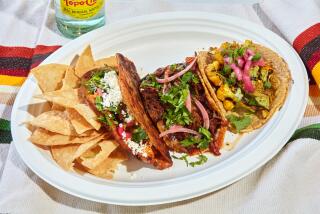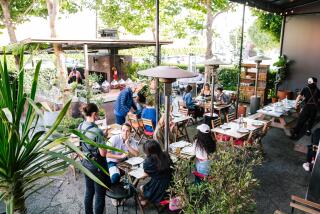L.A. County Fair’s garden bursts with strange delights
Walk past the signs for Krispy Kreme sloppy joes. Head toward the massive servings of curly fries. Turn left at the stall for chocolate-covered bacon.
Out on the edge of the L.A. County fairgrounds in Pomona is a 1-acre space packed with Mother Nature’s answer to extreme food.
There you might find the Australian finger lime, a pickle-shaped green citrus whose pulp looks like golden caviar. Nearby is the Buddha’s hand plant, whose tentacled fruit dangles from its spiny branches like a canary-colored octopus. A patch of delicate strawberry plants burst with tiny yellow berries the size of jelly beans — and almost as sweet.
These and more than 100 other exotic fruits and vegetables might seem like a horticultural freak show. But the all-organic plot marks an effort by fair organizers to promote a more healthful lifestyle and return the fair to its agrarian roots.
Quiz: Los Angeles County Fair -- giant food and four-horned sheep
Visitors can sniff 16 kinds of mint and gawk at five varieties of peaches. The fair complex’s executive chef is crafting farm-to-table banquets using the local ingredients. And by next year, the farm is to triple in size and feature a horticulture program for schoolchildren funded by a state grant.
“There will always be a place for fried Twinkies, but as an organization, I think we also want to highlight where we came from,” said David Teig, the executive chef.
When the Los Angeles County Fair first opened in 1922 and a cheeseburger between two doughnuts wasn’t a thing, the event was a celebration of agrarian life. The Times highlighted in its first-day coverage the impressive display of chickens, rabbits and tractors — products of the “nation’s richest agricultural county,” the paper said.
The modern fair has evolved into more of a gastronomic monster truck rally where visitors can push their arteries and gut to the max. It’s also something of a trade show carnival — a place to sip on margaritas, catch a pop concert and shop for RVs and Jacuzzis.
Agriculture can seem like an afterthought. But that’s recently begun to change.
A visitor survey last year showed animals and agriculture overtaking entertainment as the No. 3 reason to visit the fair. Food and shopping remained entrenched at the top.
Sky Shivers, an Oklahoman who manages the fair’s animal exhibits, said more people are crowding into the barn to see the live animal birthing shows.
“This is the only time of the year most people in Los Angeles can see animals behaving like they do on a farm,” said Shivers, who’s usually decked out in a cowboy hat and Wrangler denim. “They’re also watching more food TV and wondering where their ingredients come from.”
The calf deliveries attract about 800 people at the cattle pen, many toting cameras. Shivers, who emcees the event wearing a headset microphone, said spectators will wait up to five hours, fearful of even using the bathroom because they could lose their vantage. When the calf finally emerges onto a bed of hay, gooey birth sac and all, it can be too much for a few city slickers.
“We’ve had people throw up,” Shivers said. “I don’t understand. It’s not like it’s a surprise.”
Fairgoers may want a salad after a sight like that. If they do, they can dine at McKinley’s Grille inside the fair complex’s Sheraton hotel, where a portion of the ingredients are picked from the fairground farm.
That’s been the case since 2010, when Teig and the fair’s chief horticulturist, Don DeLano, first teamed up to plant a garden that aimed to dazzle onlookers with a bounty only Southern California-style weather could allow.
The pair pored over seed catalogs and ordered oddities like purple passion asparagus, Aztec thornless blackberries, Hungarian yellow wax chilies, red Rubin basil, Hachiya persimmons and spineless boysenberries. To compete with neighboring attractions like a giant steer and miniature horse, they knew not any old corn or squash would do.
“We try to grow things that are downright weird,” said DeLano, who has been working at the fair since 1973.
Access to the farm and the help of a master grower like DeLano is a dream come true for Teig, who grew up in a rural community near Woodstock, N.Y., and earned his first professional kitchen job at a nearby Buddhist ashram. He apprenticed at Michelin-rated restaurants in France before returning to the U.S. and working for Starwood Hotels.
Menu ideas abound on the farm. Young, green almonds were blended with shiso leaves to make a pesto for California white bass. Indian mint was added to caramelized sugar in a peach tarte Tatin. Hoja santa, a heart-shaped leaf found in South America, imparted a sarsaparilla flavor to steamed fish.
“I’m not the foam guy. I’m not the gel guy. I’m not going to get molecular. I just want to pick good ingredients and stay true to the food,” Teig said.
The grant to expand the farm will allow for more crops and space-intensive plants like giant pumpkins. Students will be taught how to cultivate and harvest produce — part of a plan to encourage youngsters to eat better.
“We want to balance fun and nutrition education to help people learn how to make their own healthy food choices,” said Karen Ross, secretary of the California Department of Food and Agriculture, which awarded the $390,000 grant.
Ross, a fan of corn dogs, said she has no objection to oily fair food — so long as it’s eaten sparingly.
Even the famed fry chef Charlie Boghosian, better known as Chicken Charlie, applauded the farm’s expansion. The man who gave the fair deep-fried Pop Tarts and fried bacon-wrapped pickles is always on the hunt for the next big thing to boil in oil.
He’s currently beta testing a deep-fried Slim Jim beef jerky. But inspiration can come from anywhere, even the fair’s epicurean farm. Battered Buddha’s hand fruit could have a future.
“I’d be more than happy to fry anything they got,” he said.
More to Read
Inside the business of entertainment
The Wide Shot brings you news, analysis and insights on everything from streaming wars to production — and what it all means for the future.
You may occasionally receive promotional content from the Los Angeles Times.











